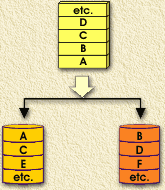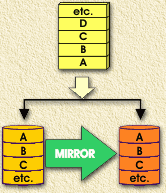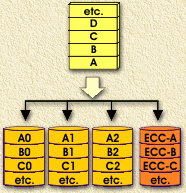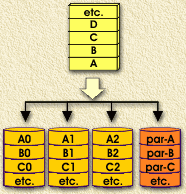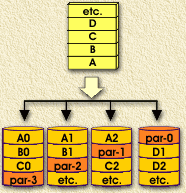
| Print this page - use Landscape |
Search the WeetHet Pages |
|||||||||||||||||||||||||||||||
| WeetHet is being updated! - Current articles will slowly move to www.tweaking4all.com For excellent webhosting that is reliable and affordable, we highly recommend: LiquidWeb |
||||||||||||||||||||||||||||||||
|
On this page ...
Overview
In a normal home PC, each hard drive is seen as an independent disk identified by letters like C,D,E, etc... Data is send by the controller to the disk you
specify directly and in proper sequency. So all the data is stored on
fysically the same disk. In a RAID system, multiple hard drives are combined into so called "arrays" of disks. Each array is seen as a single independent disk, though that array may include two, three, four, or even more drives. A RAID system also uses advanced data handling techniques that takes advantage of the fact that multiple drives are performing the work of a single drive. This includes tagged command queuing/scatter-gather/elevator seek which basically re-orders requests for data depending on their location on the hard drives. This provides more efficient use of the read/write heads, particularly in retrieving data. Using RAID arrays inside a PC offers much greater flexibility, depending on application usage. Different RAID levels perform different functions. Which RAID system should I use ? 3 Rules of thumb;
RAID-0 (also known as "striping") basically links each drive in the array as one huge drive. Storage capacity is determined by the smallest drive in the array. That capacity is then applied to format all other drives in the array. If for example you are using a 1GB, 2GB and 5GB drive in a RAID-0 array, your system will see one drive of 3GB (1GB x 3) versus the normal seperate counted 8GB. RAID-0 offers about double the performance under sustained data transfers compared to one single drive. In such a configuration, unlike SCSI, IDE drives are always available to the system. SCSI requires more management of the SCSI bus. Basically; byte1 is send to disk1, byte 2 to disk2, byte3 to disk1 again, etc... simultaniously, therefor improving performance (note that the block size is commonly something like 32 KByte or 64 KByte instead of a single byte);
Note: RAID-0 offers NO fault tolerance! If one drive fails - all data is lost! Spanning: If a user wishes to obtain all the capacity of the drives in an array, he may also choose to "span" (merge) the drives. In this configuration disks storage space will be placed sequential where the operating system sees just one huge disk. Unfortunately, there are no other benefits except capacity with the spanning solution. Note: Spanning is not supported
by all RAID controllers. RAID-1 (also known as "mirroring") makes and maintains an identical image of data from one drive to a second drive or from multiple drives to a second set of multiple drives. Should one drive fail, the working drive or drive set continues operating. To the system, such an array is still seen as a single drive letter. While RAID 1 is the least efficient use of hard drives to provide data protection (since the user does not see any of the additional storage capacity of the mirrored drives), low-cost IDE makes it acceptable. If performing 1-to-1 mirroring with two 4GB drives, the system only sees one 4GB drive. IDE RAID 1 represents a significantly lower cost than SCSI RAID 1. Basically, disk1 is an identical copy of disk2;
RAID-2 uses parallel transfer (as seen with striping in RAID-0) and a so called Hamming Error Correct Code (ECC), intended for harddisk that do not have an error detection. Since the Hamming code is very complicated and often more than one disk is required to store the Hamming code, this version of RAID does not advantages over RAID-3.
RAID-3 uses a seperate drive to store the parity calculated from the striped data (see RAID-0) on a byte-by-byte basis across the disks used. On a seperate disc this parity is stored. Once a drive fails, the controller will be able to calculate the missing data by using the parity-data. Due to this parity data, a RAID-3 system will not support simultanous reads and writes. It is optimized for large sequential data storage. Parity is calculted from byte-A0, byte-A1 and byte-A2 (in this example).
RAID-4 is identical to RAID-3 with the exception that the parity is block based and not, as seen in RAID-3, byte-based. A block is typically not byte sized. Common blocksizes are 32 KBytes and 64 KBytes. This enables simultanious reads and writes, however these can not overlap and therefor offer no advantage over RAID-5.
RAID 5 works identical to RAID-4, however the parity "block" is not stored on a single disk, but spread over the disk array. This could be seen as RAID-0, using additional parity data to make things safer - RAID-5 is best used in a network environment;
Note: RAID-5 is typically not supported by common IDE RAID controllers - the more expensive ones however do. |
||||||||||||||||||||||||||||||||


